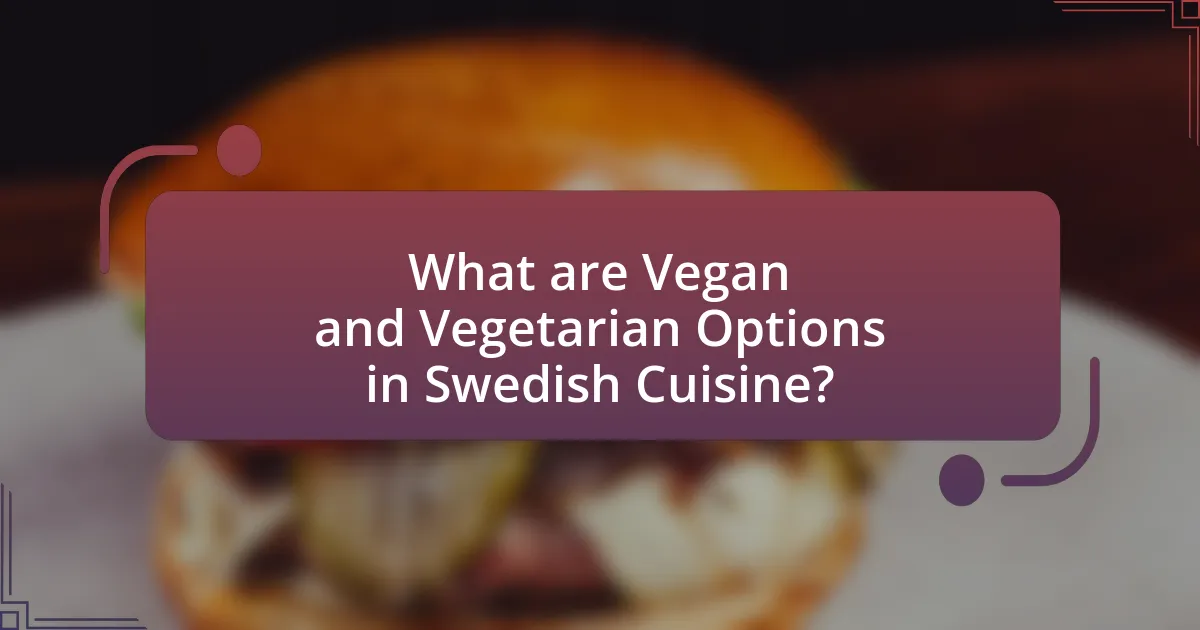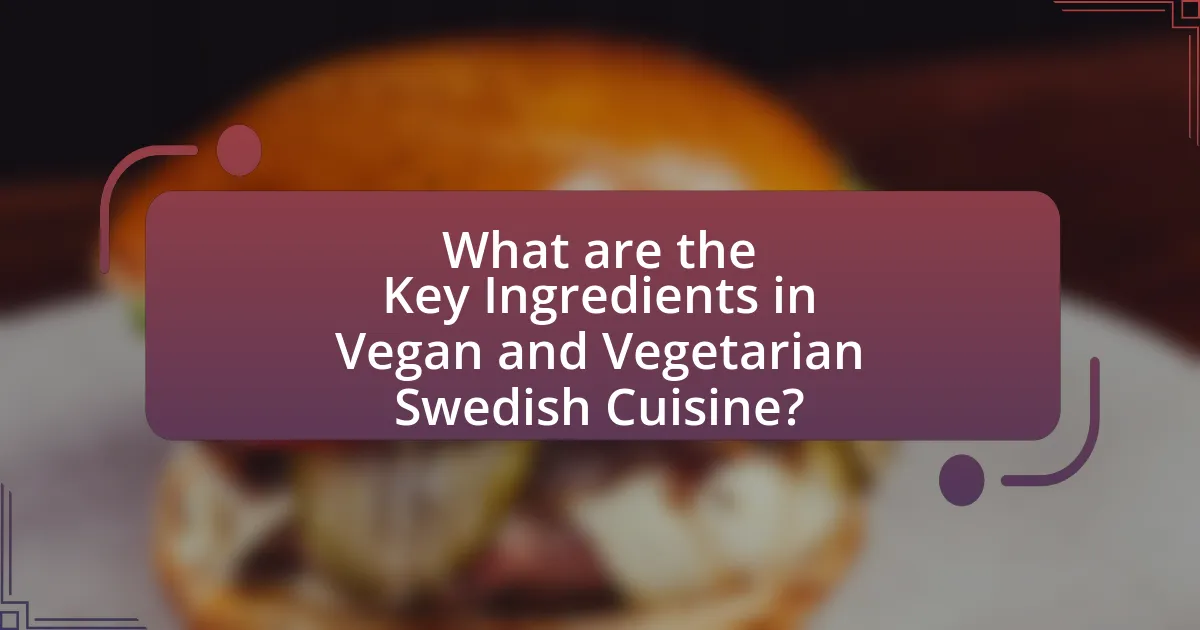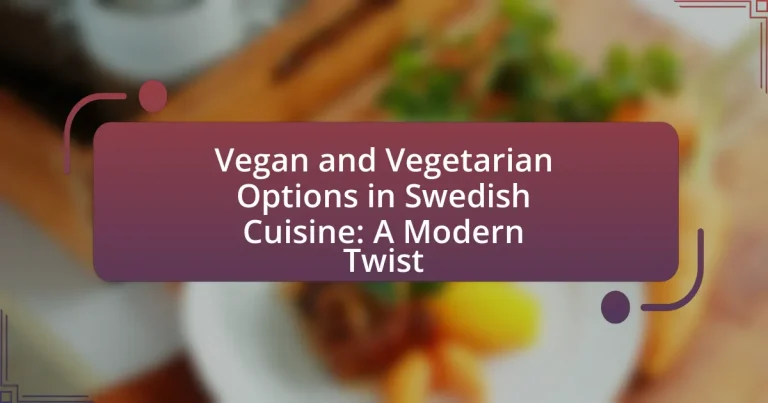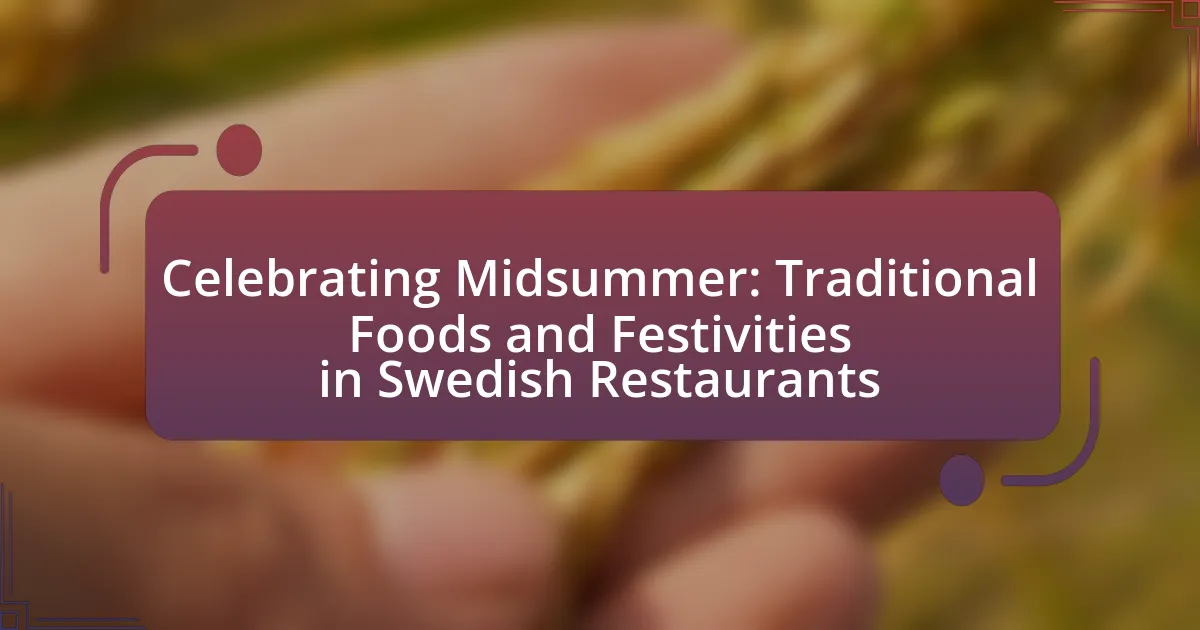Vegan and vegetarian options in Swedish cuisine have gained prominence, showcasing a modern adaptation of traditional dishes through the use of plant-based ingredients. Key adaptations include vegetable-based gravlax, mushroom meatballs, and root vegetable casseroles, reflecting a shift towards sustainability and health consciousness among consumers. The article explores how classic recipes have been modified to accommodate vegan and vegetarian diets, the influence of local ingredients, and the cultural factors driving this trend. Additionally, it highlights popular dishes, innovative cooking techniques, and best practices for recreating these meals at home, emphasizing the growing interest in plant-based eating in Sweden.

What are Vegan and Vegetarian Options in Swedish Cuisine?
Vegan and vegetarian options in Swedish cuisine include dishes such as vegetable-based gravlax, mushroom-based meatballs, and various root vegetable casseroles. These options reflect a modern twist on traditional Swedish recipes, incorporating ingredients like lentils, chickpeas, and seasonal vegetables. For instance, the use of plant-based alternatives in classic dishes like “kåldolmar” (cabbage rolls) showcases the adaptation of Swedish cuisine to accommodate vegan and vegetarian diets. Additionally, many Swedish restaurants now offer plant-based versions of traditional foods, highlighting the growing trend towards inclusivity in culinary practices.
How have traditional Swedish dishes adapted to include vegan and vegetarian options?
Traditional Swedish dishes have adapted to include vegan and vegetarian options by substituting animal-based ingredients with plant-based alternatives. For example, classic dishes like köttbullar (meatballs) are now made with lentils, chickpeas, or plant-based meat substitutes, while gravlax has been reimagined using marinated carrots or beets to mimic the texture and flavor. This shift reflects a growing trend towards sustainability and health consciousness among consumers, with a 2021 survey indicating that 30% of Swedes are actively reducing their meat consumption. Additionally, traditional recipes are being modified to incorporate more vegetables, grains, and legumes, making them accessible to a wider audience while preserving their cultural significance.
What are some classic Swedish dishes that can be made vegan or vegetarian?
Classic Swedish dishes that can be made vegan or vegetarian include köttbullar (meatballs), which can be substituted with lentils or chickpeas, and gravlax, which can be replaced with marinated carrots or beets to mimic the flavor. Additionally, Janssons frestelse, a traditional potato dish, can be made vegan by using plant-based cream and omitting anchovies. Another option is pyttipanna, which can be adapted by using plant-based sausages and vegetables. These adaptations maintain the essence of the original dishes while catering to vegan and vegetarian diets.
How do local ingredients influence these adaptations?
Local ingredients significantly influence adaptations in vegan and vegetarian options within Swedish cuisine by providing unique flavors, textures, and nutritional profiles that reflect regional agricultural practices. For instance, the use of locally sourced root vegetables, such as potatoes and carrots, enhances traditional dishes while aligning with sustainable practices. Additionally, incorporating native herbs like dill and chives adds authenticity and depth to plant-based recipes. This reliance on local produce not only supports local farmers but also fosters a culinary identity that resonates with contemporary dietary preferences, as evidenced by the increasing popularity of dishes featuring seasonal ingredients in Swedish restaurants.
Why is there a growing interest in vegan and vegetarian cuisine in Sweden?
There is a growing interest in vegan and vegetarian cuisine in Sweden due to increasing awareness of health, environmental sustainability, and animal welfare. Swedish consumers are becoming more health-conscious, with a 2021 survey indicating that 60% of Swedes are actively trying to reduce their meat consumption for health benefits. Additionally, environmental concerns are driving this trend, as the Swedish government aims to reduce greenhouse gas emissions, with plant-based diets recognized as a key strategy. Furthermore, the rise of innovative plant-based products and restaurants catering to vegan and vegetarian diets has made these options more accessible and appealing, contributing to the overall growth in interest.
What cultural factors contribute to this trend?
Cultural factors contributing to the trend of vegan and vegetarian options in Swedish cuisine include a growing emphasis on sustainability, health consciousness, and ethical considerations regarding animal welfare. The Swedish government has actively promoted plant-based diets as part of its environmental policies, aiming to reduce carbon footprints associated with meat production. Additionally, the rise of health awareness among Swedes has led to increased demand for nutritious, plant-based foods, supported by research indicating that diets rich in fruits and vegetables can lower the risk of chronic diseases. Furthermore, the ethical movement advocating for animal rights has gained traction, influencing consumer choices towards more humane food options. These interconnected cultural shifts reflect a broader societal transformation towards more sustainable and ethical eating practices in Sweden.
How does health consciousness affect dietary choices in Sweden?
Health consciousness significantly influences dietary choices in Sweden by driving a preference for healthier, plant-based options. This trend is evident in the increasing popularity of vegan and vegetarian diets among Swedes, with a reported 10% of the population identifying as vegetarian and 2% as vegan, according to a 2021 survey by the Swedish Food Agency. The focus on health has led to a rise in the consumption of organic produce and whole foods, as consumers seek to improve their overall well-being and reduce the risk of chronic diseases. Additionally, the Swedish government promotes healthy eating through initiatives that encourage the consumption of fruits, vegetables, and legumes, further reinforcing the shift towards more health-conscious dietary choices.

What are the Key Ingredients in Vegan and Vegetarian Swedish Cuisine?
Key ingredients in vegan and vegetarian Swedish cuisine include root vegetables, legumes, grains, and plant-based dairy alternatives. Root vegetables such as potatoes, carrots, and beets are staples in traditional Swedish dishes, providing essential nutrients and flavors. Legumes like lentils and chickpeas serve as protein sources, while grains such as barley and rye contribute to the dietary fiber content. Additionally, plant-based dairy alternatives, including oat milk and vegan cheeses, are increasingly used to create familiar textures and flavors in modern recipes. These ingredients reflect a shift towards sustainable and health-conscious eating in Swedish cuisine.
Which plant-based ingredients are commonly used in Swedish vegan and vegetarian dishes?
Commonly used plant-based ingredients in Swedish vegan and vegetarian dishes include root vegetables, legumes, grains, and various herbs. Root vegetables such as potatoes, carrots, and beets are staples in Swedish cuisine, often featured in dishes like vegetable stews and salads. Legumes, including lentils and chickpeas, provide protein and are used in soups and patties. Grains like barley and rye are also prevalent, serving as bases for salads and side dishes. Additionally, herbs such as dill and parsley enhance the flavors of these dishes, reflecting traditional Swedish culinary practices.
What role do grains and legumes play in these diets?
Grains and legumes serve as essential sources of protein, fiber, and nutrients in vegan and vegetarian diets. These food groups provide a foundation for balanced meals, contributing to overall health and satiety. For instance, whole grains like barley and oats, commonly used in Swedish cuisine, offer complex carbohydrates and essential vitamins, while legumes such as lentils and chickpeas are rich in protein and iron. The incorporation of these ingredients not only enhances the nutritional profile of dishes but also aligns with traditional Swedish culinary practices, promoting sustainability and plant-based eating.
How are seasonal vegetables incorporated into Swedish recipes?
Seasonal vegetables are incorporated into Swedish recipes by emphasizing their freshness and availability throughout the year, often featured in traditional dishes and modern adaptations. For example, root vegetables like carrots, potatoes, and beets are commonly used in classic dishes such as Janssons frestelse and various soups, showcasing their flavors during the colder months. In the summer, lighter dishes often highlight vegetables like asparagus, peas, and tomatoes, which are used in salads and side dishes, reflecting the seasonal harvest. This practice aligns with Sweden’s culinary philosophy of utilizing local produce, which is supported by the Swedish government’s promotion of sustainable eating habits and seasonal cooking.
How do Swedish flavors and spices enhance vegan and vegetarian meals?
Swedish flavors and spices enhance vegan and vegetarian meals by introducing unique tastes and aromas that elevate the overall dining experience. Ingredients such as dill, lingonberries, and allspice are commonly used in Swedish cuisine, providing a distinct flavor profile that complements plant-based dishes. For example, dill adds a fresh, herbal note that pairs well with root vegetables and salads, while lingonberries offer a tart sweetness that balances savory elements in vegan stews or sauces. Allspice contributes warmth and depth, making it ideal for seasoning hearty grain-based meals. These flavors not only enrich the taste but also reflect Sweden’s culinary heritage, making vegan and vegetarian options more appealing and satisfying.
What traditional Swedish herbs and spices are essential for flavoring dishes?
Traditional Swedish herbs and spices essential for flavoring dishes include dill, parsley, chives, and allspice. Dill is particularly prominent in Swedish cuisine, often used in dishes like gravlax and pickled herring, while parsley and chives add freshness to various salads and sauces. Allspice, known for its warm, aromatic flavor, is commonly used in meat dishes and baked goods. These ingredients reflect the historical and cultural significance of Swedish cooking, emphasizing the use of locally sourced herbs and spices to enhance flavors.
How can modern cooking techniques elevate these flavors?
Modern cooking techniques can elevate flavors in vegan and vegetarian Swedish cuisine by utilizing methods such as sous-vide, fermentation, and molecular gastronomy. Sous-vide cooking allows for precise temperature control, enhancing the natural flavors of vegetables and plant-based proteins while retaining their nutrients. Fermentation introduces complex flavors and probiotics, enriching dishes like fermented beetroot or pickled vegetables, which are common in Swedish cuisine. Molecular gastronomy techniques, such as spherification and foaming, can transform traditional ingredients into innovative presentations, creating new textures and flavor experiences. These methods not only enhance the taste but also improve the overall dining experience by adding visual appeal and depth to the dishes.

What are Some Popular Vegan and Vegetarian Dishes in Modern Swedish Cuisine?
Some popular vegan and vegetarian dishes in modern Swedish cuisine include “Köttbullar” made with plant-based ingredients, “Rödbetssallad” (beetroot salad), and “Grönsaksbiffar” (vegetable patties). These dishes reflect a growing trend towards plant-based eating in Sweden, with many restaurants and home cooks adapting traditional recipes to be vegan or vegetarian. For instance, plant-based meatballs have gained popularity as a substitute for the classic meat version, showcasing the versatility of Swedish culinary traditions while catering to dietary preferences.
What are the most popular vegan and vegetarian dishes currently trending in Sweden?
The most popular vegan and vegetarian dishes currently trending in Sweden include plant-based meatballs, vegan kottbullar, and various types of open-faced sandwiches known as smörgås. Plant-based meatballs have gained significant popularity due to their resemblance to traditional Swedish meatballs, often made with lentils, chickpeas, or soy. Vegan kottbullar are frequently served with lingonberry sauce and creamy mashed potatoes, appealing to both vegans and vegetarians. Additionally, smörgås topped with avocado, hummus, or seasonal vegetables reflect a modern twist on classic Swedish cuisine, showcasing the versatility of plant-based ingredients. These dishes are widely available in restaurants and are increasingly featured in home cooking, reflecting a growing trend towards plant-based diets in Sweden.
How do these dishes reflect Swedish culinary traditions?
These dishes reflect Swedish culinary traditions by incorporating local ingredients and traditional cooking methods while adapting to modern dietary preferences. For instance, the use of root vegetables, grains, and foraged herbs in vegan and vegetarian dishes mirrors the historical reliance on seasonal and locally sourced produce in Sweden. Additionally, traditional flavors such as dill, lingonberries, and mustard are often featured, maintaining a connection to classic Swedish cuisine. This adaptation showcases a commitment to sustainability and health, aligning with contemporary values while honoring the rich culinary heritage of Sweden.
What innovative twists are chefs adding to traditional recipes?
Chefs are incorporating plant-based ingredients and alternative proteins into traditional Swedish recipes to create innovative vegan and vegetarian options. For example, traditional meatballs are being reimagined using lentils, mushrooms, and oats, which not only maintain the dish’s texture but also enhance its nutritional profile. Additionally, chefs are experimenting with aquafaba as an egg substitute in classic dishes like pancakes and cakes, allowing for a lighter texture while keeping the flavors intact. This shift towards plant-based adaptations reflects a growing trend in Swedish cuisine that prioritizes sustainability and health, aligning with the increasing demand for vegetarian and vegan meals among consumers.
How can home cooks recreate these dishes?
Home cooks can recreate vegan and vegetarian dishes in Swedish cuisine by utilizing plant-based ingredients and traditional cooking methods. For example, they can make a vegan version of the classic Swedish meatballs by using lentils, mushrooms, and oats as the base, combined with spices like allspice and nutmeg to mimic the flavor profile. Additionally, traditional dishes like Jansson’s Temptation can be adapted by substituting cream with coconut milk and using vegan butter for the potato gratin. This approach not only preserves the essence of Swedish cuisine but also aligns with modern dietary preferences.
What are some tips for sourcing ingredients for vegan and vegetarian Swedish cooking?
To source ingredients for vegan and vegetarian Swedish cooking, prioritize local and seasonal produce to ensure freshness and sustainability. Utilizing farmers’ markets and local co-ops can provide access to organic vegetables, fruits, and grains that are staples in Swedish cuisine, such as potatoes, root vegetables, and berries. Additionally, consider exploring specialty stores for plant-based alternatives to traditional Swedish ingredients, like vegan cheeses and plant-based meats, which are increasingly available due to the growing demand for vegan options. Research indicates that local sourcing not only supports community agriculture but also enhances the flavor and nutritional value of meals, aligning with the principles of Swedish culinary traditions that emphasize quality and simplicity.
How can one adapt traditional recipes for a vegan or vegetarian diet?
To adapt traditional recipes for a vegan or vegetarian diet, one can substitute animal-based ingredients with plant-based alternatives. For example, dairy can be replaced with almond milk or coconut yogurt, while eggs can be substituted with flaxseed meal or aquafaba. Additionally, meat can be replaced with legumes, tofu, or tempeh, which provide similar textures and protein content. This approach aligns with the growing trend of plant-based eating, as evidenced by a 2021 report from the Plant Based Foods Association, which noted a 27% increase in plant-based food sales in the U.S. from the previous year. By making these substitutions, traditional recipes can be successfully modified to meet vegan or vegetarian dietary preferences.
What are the best practices for enjoying vegan and vegetarian Swedish cuisine?
To enjoy vegan and vegetarian Swedish cuisine, focus on incorporating traditional ingredients like root vegetables, grains, and legumes while exploring modern adaptations. Utilizing seasonal produce enhances flavor and sustainability, as Sweden emphasizes local sourcing. For instance, dishes like vegan kottbullar (meatballs) made from lentils or chickpeas reflect traditional flavors while being plant-based. Additionally, experimenting with classic sauces, such as lingonberry or mustard, can elevate the dining experience. Engaging with local Swedish cookbooks or online resources can provide authentic recipes and insights into the cuisine’s cultural significance, ensuring a deeper appreciation of the dishes.





